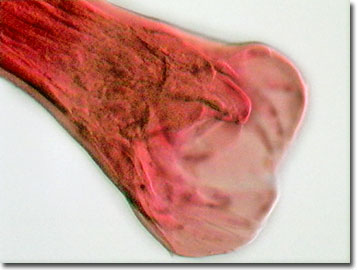Oblique Digital Image Gallery
Brazilian Hookworm (Necator americanus)
Hookworms, parasitic representatives of the phylum Nematoda (roundworms) were first isolated in 1865 by Brazil's pioneering physician and hematologist, Dr. Otto H. Wucherer. He was also the first to describe the embryonic filaria, a parasite that leads to hematuria and elephantiasis, which he published in the European science journals. In Brazil, two species of hookworm that infest people, Ancylostoma duodenale and Necator americanus, were the subject of a 1920s eradication program funded by the Rockefeller Foundation.

Known as a form of helminthiasis, Brazilian hookworms are transmitted to humans via soils infected with the helminths and human feces. Treatment is recommended using an antihelminthic drug such as albendazole or oxamniquine. In Brazil, the highest risk groups for hookworm infestations via contaminated soils are preschool children and women of childbearing age. Prevention may also involve using only treated wastewater for food crop irrigation rather than raw human sewage.
Paleoparasitology, a relatively new branch of parasitology, examines archaeological materials for evidence of parasite-host relationships that have coevolved through time. The science is also concerned with and how humans and their parasites may have migrated across the continents. Hookworm eggs have been discovered in human coprolites (fossil fecal matter) in South American archaeological digs dating back 7,200 years, and in the intestines of Brazilian mummies more than 2,000 years old. Paleoparasitologists have deduced that some of the parasitic hookworms observed today in Brazil are not recent introductions (N. americanus), but have been infesting the local population for many years. The other major hookworm species plaguing Brazilians, Ancylostoma duodenale, is an Old World native that may have been introduced by European voyages to the New World.
Contributing Authors
Cynthia D. Kelly, Thomas J. Fellers and Michael W. Davidson - National High Magnetic Field Laboratory, 1800 East Paul Dirac Dr., The Florida State University, Tallahassee, Florida, 32310.
BACK TO THE OBLIQUE IMAGE GALLERY
BACK TO THE DIGITAL IMAGE GALLERIES
Questions or comments? Send us an email.
© 1995-2025 by Michael W. Davidson and The Florida State University. All Rights Reserved. No images, graphics, software, scripts, or applets may be reproduced or used in any manner without permission from the copyright holders. Use of this website means you agree to all of the Legal Terms and Conditions set forth by the owners.
This website is maintained by our
Graphics & Web Programming Team
in collaboration with Optical Microscopy at the
National High Magnetic Field Laboratory.
Last Modification Friday, Nov 13, 2015 at 01:19 PM
Access Count Since September 17, 2002: 24950
Visit the website of our partner in introductory microscopy education:
|
|
